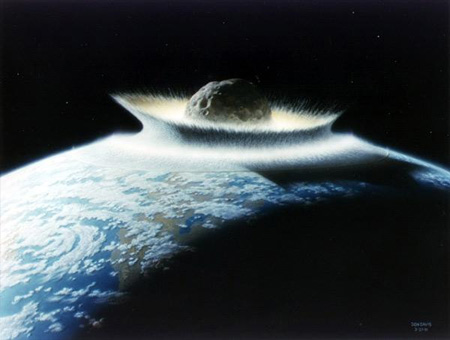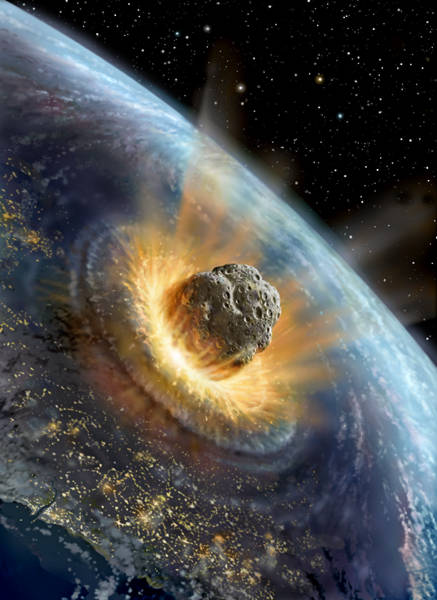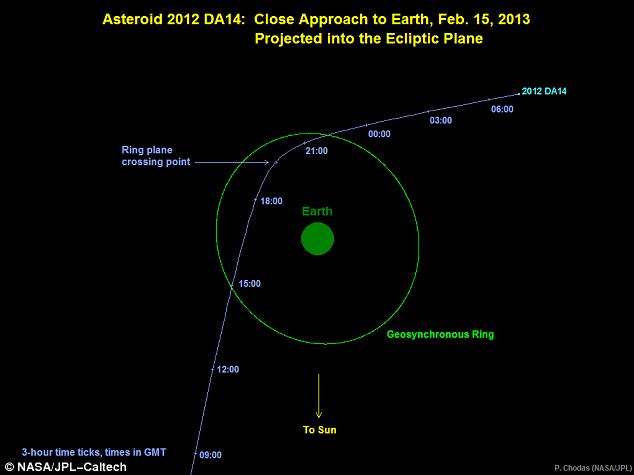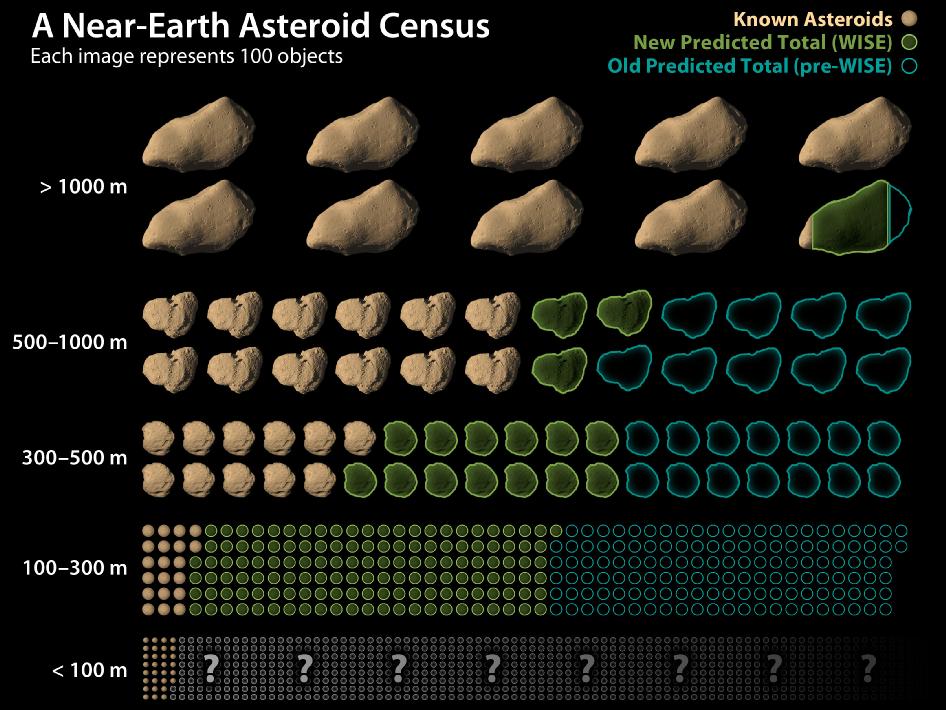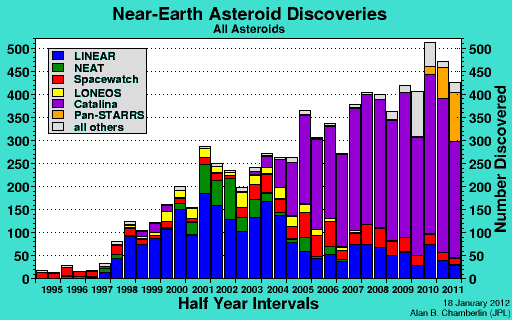Issues: Near Earth Objects
Near Earth Objects are objects from space ~ asteroids, meteors and comets ~ that pass dangerously close to the the Earth on their orbits around the Sun.
Scientists are currently mapping the sky to find the NEOs.
According to NASA's Near Earth Object Program, there are currently about one thousand known PHAs (Potentially Hazardous Asteroids).
Scientists have since received more funding for identifying and preparing plans to deal with this natural threat.
These collisions have happened in the past and these bodies will continue to present themselves in the future.
We are the only creatures on Earth who have the capability to divert these dangerous bodies from a collision with our home world.
Scientists are calling for international cooperation to develop the capability to divert these bodies into stable non-threatening orbits when necessary.
See the links below for lists of NEOs and PHA monitored by NASA and other organizations.
Recent NEO Events
•1992 - 1994 - In the summer of 1992, the Comet Shoemaker-Levy9 broke up into pieces. Then two years later, in July 1994, the remains all dove into Jupiter leaving several scars the size of our own planet. Had this large comet been on a track to Earth, our planet would have been all but destroyed. Nothing more complex than bacteria or molds would have survived in the remains. This is the nightmare that only we, among all the creatures of the Earth, have the power to prevent. (See Carol Shoemaker's quote below)
•2003 August 24 - Asteroid 2003 QQ47 about 1.2 km wide was discovered by the Lincoln Near Earth Asteroid Research Project (an MIT Lincoln Laboratory program funded by the US Air Force and NASA) in New Mexico. 2003 QQ47 was initially classified as a #1 threat on the Torino scale of impact hazards. See below the reappearance on 2014 March 26.
•2007 January 29 - Asteroid 2007 TU24 made its closest approach to Earth at 12:33 am UT on Jan. 29 2007. At its closest point, the asteroid was 554,209 kilometers (344,370 miles) from Earth, or roughly 1.4 times the distance between the moon and Earth.
•2008 February - Asteroid 2008 CT1 flew past the Earth only 72,000 miles away. That is 0.3 lunar distances or stated another way - 1/3 the distance to our Moon. This was a very close approach. It was not large, however, only about the size of a large school bus - 13 meters wide. If it had struck the Earth, it would have probably exploded into fragments in the atmosphere and sent small shards across the Earth, doing little damage.
•2008 October 7 - Asteroid 2008 TC3 exploded in the atmosphere over Sudan. The asteroid was calculated to be about 4 meters wide and exploded about 37 km above Sudan. The explosive force was estimated to be about 2 kilotons of TNT.
•2009 October 8 - An asteroid (2009 Sulawesi Superbolide) exploded in the atmosphere over Sulawesi Indonesia. The asteroid was calculated to be about 5-10 meters wide and exploded about 15-20 km above the Earth. The explosive force was estimated to be about 40-50 kilotons of TNT.
•2013 February 15 - Asteroid 2013 DA14 passed by Earth. The same day, a unrelated meteor traveling in a different direction exploded over Chelyabinsk in Russia's Ural mountains, damaging hundreds of buildings with the sonic blast and injuring about a thousand people.
•2013 September 18 - The small Asteroid 2013 RZ53 passed by Earth inside the orbit of the Moon.
•2013 Fall to 2014 Spring - Comet ISON slowly passed by Earth with a closest distance of 1,860,000 kilometers or 1,150,000 miles.
•2014 March 26 - Asteroid 2003 QQ47 passed by Earth at a closest distance of 19 million kilometers or almost 12,000,000 miles. This asteroid has a length of about 1 kilometer.
•2022 July 29 - The 120-200 meter wide asteroid known as 2016 CZ31 passed by Earth within a distance of 2,800,000 km or 1,740,000 miles.
•2023 September 6th to 9th - Five sizeable Potentially Hazardous Asteroids passed by Earth. The largest one, 2023 QE8, was about 50 meters or 160 feet in length and passed by at a distance of about 1,520,000 kilometers or 945,000 miles.
Upcoming NEO Events
•2029 April - Asteroid 'Apophis' 99942 (2004 MN4) is due to approach Earth. At 325 meters wide (over 1000 feet), it is substantial. This is expected to be a historically close visit. The asteroid is expected to pass by our communication satellites, about 29,470 km (18,300 miles) or 4.6 Earth radii from the surface of our planet. It may be visible as a spot of light crossing the sky.
•2029 - Asteroid 153814 (2001 WN5) will pass 155,000 miles (248,700 km) from Earth.
•2036 - Asteroid 'Apophis' 99942 (2004 MN4) is expected to pass by again.
"Until then, no one had seen a comet so completely disrupted with its fragments all lined up and in orbit about a planet; no one had ever seen the impact upon a planet of a comet or an asteroid.
This comet was nature's grand experiment for man to learn about the structure and makeup of comets, impact dynamics, the chemistry of Jupiter's clouds and, most importantly, to gain the awareness that, yes, objects can fall out of the sky and impact planets, including ours.
The discovery of 31 other comets and of many near-Earth asteroids was also important as a foundation for our understanding of our solar neighbourhood and the origin of our solar system."
"How does one stand back and evaluate themselves?
I would like to think that I made an important contribution in planetary astronomy with my pursuit of comets, planet-crossing asteroids, and impact craters and with a role in the education of others as to the importance of these bodies.
Because my work preceded that of all but a small group involved in the search for near-Earth objects, it served to call more attention to them and to provide a base knowledge about the origin of our solar system and its solid bodies."
Carol Shoemaker (regarding Comet Shoemaker-Levy, 1992-1994)
Resources & Links
- The next five asteroid approaches
- NASA Center for NEO Studies
- NASA JPL Near Earth Object
- NASA Asteroid & Comet Impact Hazards
- Harvard List of Forthcoming Close Approaches
- NASA JPL Apophis
